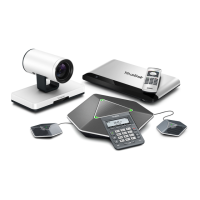Administrator’s Guide for Yealink Video Conferencing Systems
62
regardless of their physical location can greatly simplify network design. VLANs can address
issues such as scalability, security, and network management.
The purpose of VLAN configurations on the system is to insert a tag with VLAN information to
the packets generated by the system. When VLAN is configured on the system properly, the
system will tag all packets with the VLAN ID. The switch receives and forwards the tagged
packets to the corresponding VLAN according to the tag’s VLAN ID, as described in IEEE Std
802.3.
In addition to manual configuration, the system also supports automatic VLAN discovery via
LLDP or DHCP. The assignment takes effect in the following order: assignment via LLDP, manual
configuration, then assignment via DHCP.
For more information on VLAN, refer to
VLAN Feature on Yealink IP Phones
.
LLDP
LLDP (Linker Layer Discovery Protocol) is a vendor-neutral Link Layer protocol, which allows the
system to receive and/or transmit device-related information from/to directly connected
devices on the network that are also using the protocol, and store the information about other
devices. LLDP transmits information as packets called LLDP Data Units (LLDPDUs). An LLDPDU
consists of a set of Type-Length-Value (TLV) elements, each of which contains a particular type
of information about the device or port transmitting it.
LLDP-MED (Media Endpoint Discovery)
LLDP-MED is published by the Telecommunications Industry Association (TIA). It is an extension
to LLDP that operates between endpoint devices and network connectivity devices. LLDP-MED
provides the following capabilities for the system:
Capabilities Discovery -- allows LLDP-MED system to determine the capabilities that the
connected switch supports and has enabled.
Network Policy -- provides voice VLAN configuration to notify the system which VLAN to
use and QoS-related configuration for voice data. It provides a “plug and play” network
environment.
Power Management -- provides information related to how the system is powered, power
priority, and how much power the system needs.
Inventory Management -- provides a means to effectively manage the system and its
attributes, such as model number, serial number and software revision.
TLVs supported by the system are summarized in the following table:
The network address of the system.
The MAC address of the system.
Seconds until data unit expires.

